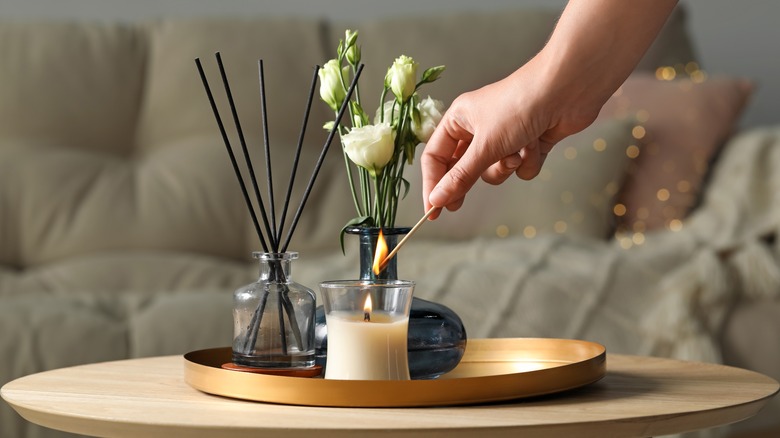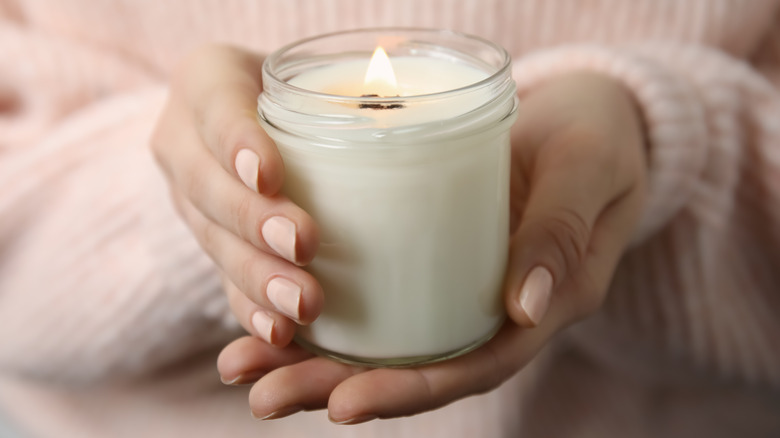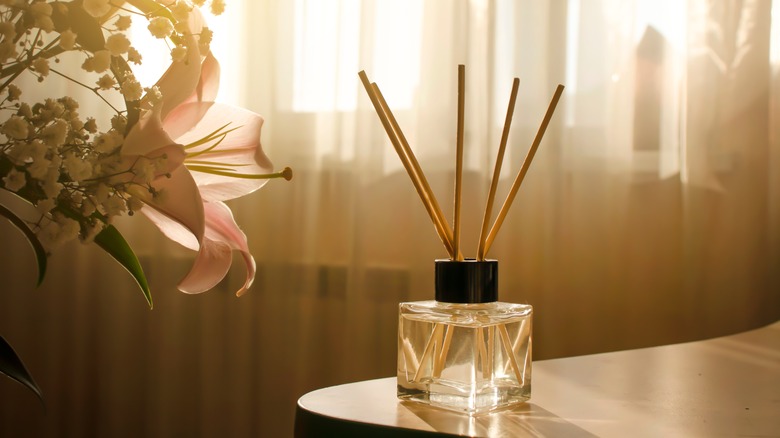Reed Diffusers Vs Scented Candles: Which Is Better For Your Home?
Once upon a time, people depended on candles and oil lamps to light their homes, but since the advent of electricity, candles have served an entirely different purpose. Even if you don't need them for light, you may still enjoy decorating your home with candles and watching the cozy flicker of the flame. However, because modern day candles are mostly used for adding fragrance to a home, they've come into competition with other — and arguably better — scent producing devices like reed diffusers. As you're standing in the home décor aisle, it's normal to question whether a scented candle or a reed diffuser is better for your home. While each has its benefits and drawbacks, using a reed diffuser is a much safer way to scent your home, and its slow diffusion properties make it much more efficient.
Still, you may not want to retire your candles for good just yet. Neither option is perfect, and candles certainly set an ambiance that a bundle of reeds can't compare to, but candles have some hidden health risks beyond the obvious open flame. Learn more about the hidden dangers of candles and the pros and cons of each home scenting option so you can make a bright choice for yourself and your household.
The candle conundrum
One of the biggest downsides to scented candles is the amount of upkeep they require. You'll need matches and tools to keep them burning, and they can't be left unattended, especially around children and pets. Most large candles burn at a rate of 5 to 7 hours per ounce of wax, but it's not wise to burn them for more than a few hours at a time. For safety reasons, candles should be extinguished, cooled, trimmed, and relit at least once every four hours, according to the National Candle Association. That's a lot of work, especially if you want to have continuous fragrance released throughout your home.
Besides the annoyance of relighting candles, there are negative health effects associated with burning too many. Candles, especially cheap candles, produce soot from their wicks and project chemicals into the air. Some can even release potentially dangerous compounds such as toluene and benzene, which are commonly found in paint thinners, adhesives, and other harsh products, per Cleveland Clinic. Toluene and benzene can cause headaches and anxiety, as well as irritate the eyes, nose, and throat — not so relaxing, after all. It's worth noting that not all candles are created equal, and they can still come with some benefits. High-quality, all-natural candles run a much lower risk of containing toxic chemicals. Stick to soy or beeswax candles with wood wicks when you want to create a cozy ambiance and enjoy instant, strong fragrance.
In defense of diffusers
In general, a reed diffuser is a safer, healthier, and more efficient way to scent your home than a standard candle. They can be more expensive, but this is because they are often made with higher quality ingredients and concentrated fragrances that can last for months. While they don't emit ambient light, reed diffusers do provide a constant, clean, and soothing scent that won't overwhelm your guests or give you headaches, even if you put a reed diffuser in every room. With a reed diffuser, you can easily set it and forget it. No need to trim wicks, keep matches on hand, or worry about accidentally starting a house fire.
Although they are safer and simpler to maintain, reed diffusers still come with some negatives. Diffuser oils and fragrances are typically contained in glass or ceramic bottles, which can easily spill, break, and stain fabrics if they're knocked over. The liquids they contain can be harmful if ingested, so it's important to place diffusers well out of reach of children and pets. Finally, reed diffusers are highly flammable, so you should always use extreme caution to avoid placing them near an open flame or in direct sunlight. If you can't bear to part with your scented candles, that's okay! Lighting a candle now and then isn't likely to harm anyone, and it's great for setting a relaxing atmosphere. In that case, perhaps candle warming lamps would be a good compromise.


